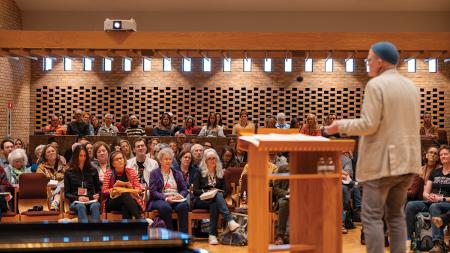Speaker Tells Audience to Ban Term 'Color Blind'

Alan Headbloom
Chris Meehan
When Barack Obama became president, many people said his election was a sign that the United States had become a color-blind nation.
In truth, the U.S. had not become color blind, given that there is really no such thing, outside of having a medical condition, of anyone being color blind, a cross-cultural communication specialist recently told a group gathered for a “Lunch and Learn” at the Grand Rapids office of the Christian Reformed Church.
“We live in a time when it is politically correct to say we are color blind to the differences of the people around us,” said Alan Headbloom of Headbloom Cross—Cultural Communication.
In fact, referring to ourselves as color blind is a form of denial and defeats the purpose of trying to establish equality between people, he said.
“If we say ‘I don’t see color,’ it says to the other person ‘I don’t see you,’” Headbloom commented. “The truth is that people do see the differences.”
Headbloom’s presentation, sponsored by the CRC’s Office of Race Relations, was titled “I Don’t See Race and Other American Racial Myths.”
Esteban Lugo, director of the Office of Race Relations, says Headbloom’s goal was to challenge people to consider the language they use.
“We need to learn to ask people questions as to what do they mean when people say things that seem or sound racist. Racism has a language that needs to be challenged intentionally in us and in others,” he said.
Headbloom said he would like to see such terms as “color blind” struck from the popular culture, given that they are so misleading and don’t represent the reality of who we are as human beings.
“Our upbringing and the media and other sources have taught us to believe certain racially unequal things,” he said.
“There are people who are intentionally racist, but often for most people it is unintentional.”
He offered a look at various studies that indicated how racial bias is real and how it plays out in the world today.
For example, many white police officers grew up being taught things about blacks and, when confronted by blacks in certain situations, tend to react in particular ways, he said.
“There are police officers who, through no fault of their own, have heightened fear in which they respond first and think second,” said Headbloom.
“And we are all like this. We have subliminal messages coming at us day after day and we don’t even realize it.”
The key, he said, is to step back and realize a few things.
Genetically, we all share more than 99 percent of the same DNA. We are only different in a few things such as skin tone and hair texture, he said.
But, just as important, we need to become aware of the “tribe” or the group in which we were raised and in which we live, and realize how those things we have been taught about others affect our behavior today.
“We need to realize we have all been brought up with certain lenses that we see through and patterns we lives by,” he said.
“We are all imperfect and have these prejudices and, by becoming aware of them, that will speed our growth.”


